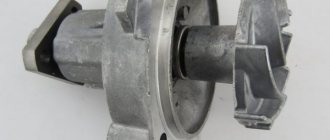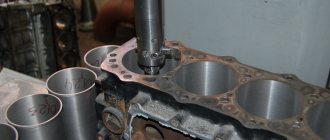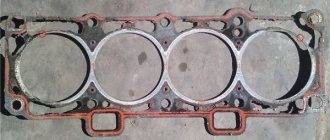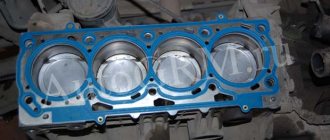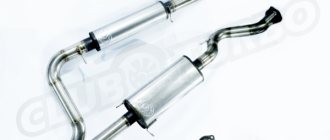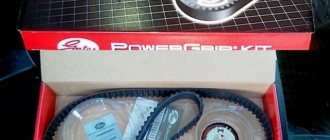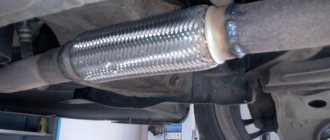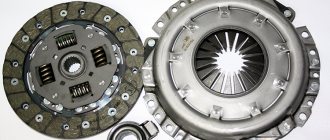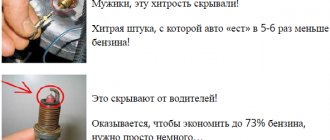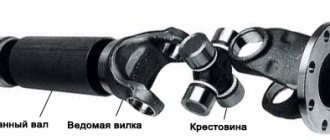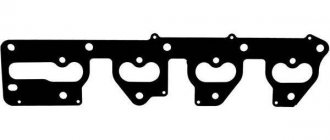Any experienced car owner will tell you that a stable cylinder head is a guarantee of reliable functioning of the car’s engine. A VAZ 2107 cylinder head in good condition reduces fuel consumption and improves vehicle dynamics.
VAZ 2107 car
Inexperienced car owners should know that head repair work should be carried out only by highly qualified specialists. Otherwise, an incorrectly adjusted unit can lead to damage to many engine components. Restoration work can cost a considerable amount. But experienced car enthusiasts with the required skills can replace, repair and tighten cylinder head bolts themselves.
[ To uncover]
[Hide]
Step-by-step guide to replacing the cylinder head gasket of a VAZ-2107
To replace the cylinder head gasket in a VAZ-2107, you should perform the following manipulations:
- The initial stage involves dismantling the filter that filters the incoming air flows. If the VAZ-2107 is equipped with a carburetor, this is easier to do than performing the same work with an injector. Your task is to unscrew and disassemble all the parts of the entire system; this is the only way to get to the cylinder head.
- Remove the carburetor.
- Unscrew absolutely all pipes that remain visible.
- Get rid of the cylinder head cover by disconnecting the fasteners. Put the nuts and clamps aside, do not lose them, otherwise you will not be able to assemble the mechanism into a single whole.
- Place a container under the hose and carefully drain the remaining coolant in the car.
- Protect your health from electrical current by removing the battery.
- Place the ignition distributor cap aside.
- Pull out the hoses from the carburetor - one responsible for heating, and the second coming from the vacuum format regulator, which distributes the ignition.
- Remove the air collector and remove the throttle linkage.
- With your own hands, remove the sensor that controls the temperature regime from the cylinder head of the VAZ-2107.
- Connect the indicators on the camshaft drive sprocket with the markings located on the camshaft bearing housing. This simple technique will avoid re-installation of the distribution phase at the time of assembly.
- Next, bend the edges of the sprocket fixing washer in different directions and unscrew the bolt. Let the star remain in its place.
- Loosen the tensioner nut half a turn and use a screwdriver to press out the shoe. As the chain loosens, tighten the fasteners again.
- All that remains is to disconnect the bolt holding the sprocket and remove it. To prevent the timing chain from falling, support it with a soft wire.
- Remove the housing base from the bearing located on the camshaft and disconnect the nuts of the VAZ-2107 cylinder head.
- When the head cover comes off easily, position the new gasket.
- Assemble the components into a single whole, following the reverse order of the proposed instructions.
- Correct valve operation.
Removing the cylinder head
Sequencing:
- Remove the battery. This will provide convenient access to the GBS head and protect against short circuits.
- Remove the air filter.
- Remove the carburetor on the carburetor version of the engine.
- Remove the ignition wires and distributor (if equipped).
- Drain the coolant from the cylinder head by unscrewing the plug. Before draining, you need to wait until the engine has cooled down.
- Loosen the clamps and disconnect the rubber pipes of the cooling system going to the cylinder head.
- Remove the valve cover by unscrewing the 8 nuts and removing them along with the shaped pressure washers.
- Loosen the chain tensioner by unscrewing the fixing nut. For convenience, you can completely dismantle it.
- Using a screwdriver and hammer, bend the edges of the lock washer on the camshaft gear mounting bolt and unscrew the bolt. Remove the gear. Tie the chain removed from the gear with wire so that it does not fall into the engine sump.
- Unscrew the camshaft mounting nuts (10 pieces) and remove it.
- Unscrew the brass nuts securing the exhaust pipe to the exhaust manifold and remove it along with the gasket.
- Using a powerful wrench, unscrew the 10 bolts that tighten the cylinder head and the eleventh bolt installed on the head casting. Remove the head. It is quite heavy, so in order not to scratch the car, it is better to remove it from the block together.
Video about replacing the cylinder head on a VAZ
Replacement of cylinder head gasket VAZ 2114(2115)
On VAZ models 2113-14-15, injection 8-valve engines are mainly installed, so replacing the cylinder head gasket of a VAZ 2114 (2115) is slightly different from replacing the cylinder head gasket on a “nine”.
Unlike 2109 on the “fourteenth” and “fifteenth” models:
- the air filter housing is removed differently, and along with it you also need to disconnect the injector corrugation (pipe) and the plug from the air flow sensor;
- otherwise the fuel hoses are disconnected;
- there is no distributor on the engine, but the pipe goes behind the cylinder head;
- it will be necessary to remove the high-voltage wires, and it is better to remember their installation order (sometimes they are not numbered);
Otherwise, there are no fundamental differences in replacing the cylinder head gasket 2114 from 2109.
Gasket replacement and assembly
If your car had pronounced symptoms of a gasket failure, then you don’t even have to look for its damage; it still won’t be possible to repair it. Immediately buy a new one and put it in place. But you need to clean the entire surface that the gasket is attached to beforehand. There should be no remnants of the old one left. You can even evaluate how smooth the surface of the head and the block itself are. It is quite possible that the cylinder head has an uneven surface, which is why, no matter what gasket is installed, it very quickly begins to leak antifreeze or air.
Before installing the VAZ 2107 cylinder head, it is necessary to check the serviceability of all valves. If there is such a need, replace the seals. This will reduce oil consumption. When everything is complete, place the gasket on the block. Place the head on top. Please note that there are two types of gaskets - old and new. The latter is produced by a very thin layer of sealant around the entire perimeter.
Do not forget to align the gasket so that it is positioned as accurately as possible. There are two guides for this purpose. And the time has come to tighten the cylinder head of the VAZ 2107. First, tighten all the bolts and tighten them by hand until they stop. And then you arm yourself with a torque wrench and, according to the diagram, tighten it. This diagram is shown in the figure. However, it is not difficult to remember it, since everything happens criss-cross.
It is necessary that all bolts are tightened as evenly as possible. To do this, they need to be pulled in two or three passes. During the first, the tightening torque of the VAZ 2107 cylinder head is 4 kgf*m. During the second pass, you need to set the moment to 11.5 kgf*m. The small bolt should be tightened to approximately 3.8. Installation of the camshaft is carried out in almost the same way; its fastenings will need to be tightened crosswise, but the moment here is not so important. The main thing is not to break the thread.
That's it, assemble your VAZ 2107 and try to start it. Just remember to fill the cooling system with water. If the engine is working perfectly and the gasket does not allow air or water to pass through, then you can add antifreeze.
Many drivers are concerned about a fairly common issue, namely replacing the cylinder head gasket of the VAZ 2107. Cars of this model have proven themselves well on our roads and in our operating conditions. But problems associated with the repair and replacement of certain components and systems remain and many have to be solved independently.
The replacement process itself, both with an injector and on an engine with a carburetor on a VAZ 2107, is simple and in order to cope with it, you just need to carefully study the material we offer and watch the video.
What to consider when choosing a new product
In order for the gasket to perform its functions, it must be resistant to elevated temperatures and have the ability to compress. These properties depend on the material of manufacture. There are several options for making gaskets: from asbestos, paronite, metal and their combinations.
This is interesting: Peugeot 206: Do-it-yourself replacement of spark plugs on a car
Combined options, layers of which are made of different materials, combine several properties. Gaskets made of asbestos and metal alloys have increased resistance to high temperatures, but do not strengthen the seal between the head and the cylinder block. Products made of paronite and rubber provide high-quality sealing, but their limit for high temperatures is lower. When choosing a gasket, preference should be given to products of a combined type.
In order not to make a mistake when choosing a seal, it is necessary to take into account the characteristics of the power unit that is installed on the car. The VAZ 2107 can be equipped with one of three types of engines. They differ in cylinder diameter. The power unit 2103 has a diameter of 76 mm, while the 2105 and 2106 have a diameter of 79 mm. If you install a gasket of the wrong diameter, the edges of the seal will be damaged. Naturally, the seal will be broken.
Which cylinder head gasket is the best?
The sealing gasket serves to strengthen the engine cooling channels and well preserves the oil channels in the cylinders that have the gas distribution function. Therefore, it is not worth saving on the cylinder head gasket. If the part is of poor quality, a breakthrough may occur between the cooling system channel and the drainage channels of the lubrication system. There is a breakthrough located at the junction of the cooling system channel and the cylinder.
By the way, the same thing happens when the cylinder head is loosely tightened, but in any case the gasket will have to be changed.
Automotive stores sell the following types of cylinder head gaskets intended for installation in the VAZ-2107:
- Asbestos - involves associated engine repairs. The advantages of the material are heat resistance, increased elasticity, and good elasticity characteristics.
- Non-asbestos products are also easy to use, and all thanks to minimal shrinkage and excellent restorative properties.
- Metal ones are considered the best among all other cylinder head seals. The point is that the pressure is distributed evenly throughout the block.
A video of how to replace the cylinder head gasket of a VAZ-2107 with your own hands can be seen below:
Step by step guide
VAZ 2107 cylinder head in the engine compartment
Many problems can be solved after tightening the bolts, but if this does not help, then a major overhaul of this unit may be necessary, which involves removing not only the cylinder head, but also other parts of the block. Some parts may need to be replaced, such as gaskets, valve stem seals and valve guides.
Tools
To work we will need the following tools:
- a set of keys;
- micrometer;micrometer
- flushing liquid;
- pliers;
- hammer;
- mandrels for removing and installing valves and caps;
- torque wrench;torque wrench
- tiles (preferably the spiral is closed);
- desiccant.Valve desiccant
Before starting repair work on the cylinder head, it must first be removed and cleaned of dirt.
Stages
Preparatory work and head removal
- The first step is to drain the coolant from the engine.
- We remove the carburetor.
- Having disconnected the pipes and hoses, remove the air barrier. Disconnect the hoses and pipes
- Remove the head cover.
- We align the marks on the crankshaft pulley with the mark on the camshaft drive and the marks on the camshaft pulley with the mark on its body as shown in the photo. Aligning the marks
- By disconnecting the camshaft lock washer, loosen the chain tension.
- Having torn off the bolt, remove the sprocket.
- Unscrew the fastenings.
- We remove the camshaft with the housing. Camshaft
- Having previously made marks using a marker, remove the rockers. Removing the rockers
- Disconnect the wires.
- We remove the pipe and unscrew the bolts securing the cylinder head to the block.
- We remove the head.
- We inspect its condition and clean it of dirt. Inspection of the condition of the head
This video shows the process of removing the cylinder head.
Checking status
Now it's time to dry out the valves. This is done with a special device. If chips, cracks, and rust are not visible, we conduct a further inspection. We evaluate the condition of the saddles, the repair of which is recommended every two hundred thousand kilometers.
Changing guide bushings
We inspect the guide bushings; if they are in unsatisfactory condition, they must be replaced.
A special tool is used to remove them. If you don’t have this on hand, you can get by with pliers and a clamp. After removing the bushings, we measure their diameter. We buy similar ones, the size of which is 0.05-0.07 millimeters larger than the ones being replaced.
The guides are pressed in using a mandrel, an electric stove, a hammer and lubricant.
- We place the head on a stand at the edges.
- We place the electrical device under the place of work.
- We wait until the metal heats up to about one hundred degrees (so that it expands).
- Now you need to properly lubricate the bushing with grease.
- Having removed it from the holders, we drive in new guides.
- When all eight are replaced, we wait for the cylinder head to cool down.
- The valves should not dangle and move freely, there should not be any jamming.
Checking the tightness of the head
Leak test
To ensure a tight fit of the valves to the seats, you must do the following. Using lapping paste, lubricate the valve and insert it into the head. There are several techniques for rotating it, here are some of them:
- using a hose tightly placed on the part;
- using a device very similar to a corkscrew.
The main sign of good valve lapping will be a specific matte surface of the seat in the place where it contacts the part.
The tightness of the head can be checked by pouring kerosene into the collectors; you can also use gasoline. If done correctly, there should be no leaks for the first five to seven minutes.
Attention! All engine parts must be washed with a special solution, this will ensure long-term and uninterrupted operation of the power plant for a long time.
When assembling the head, be sure to pay attention to the correct tightening of the bolts. It must be carried out strictly according to the scheme. In case of incorrect broaching, distortions may appear and, as a result, all your previous work will be crossed out. If you have any questions, watch the video.
You are repairing the cylinder head on your car
Survey
- On one's own
- At the service station
- No problems yet
Loading …
Cases when it is necessary to replace cylinder head gaskets
Replacing the cylinder head gasket of the VAZ-2107 is mandatory in a number of cases:
- If there is damage near the combustion chambers, engine overheating leads to this unpleasant situation. When the cooling system malfunctions, and the driver prefers not to pay attention to the malfunction and puts off repairs, the condition of the cylinder block and its head leaves much to be desired.
- A leak of antifreeze or coolant is noticed - a breakdown is often accompanied by incorrect operation of the ventilation device, thermostat, or a banal leak of substance from the hoses.
- There is an engine oil leak. If traces of oil leakage are noticed on the outside, it means the gasket is not fitting well. Tighten the head bolts, if this does not help, then you will have to replace the cylinder head gasket yourself.
When is it necessary to replace the cylinder head seal?
When a gasket burns out, the damage is significant: integrity is lost, the part loses its shape. In the event of a breakdown, the damage is minor, sometimes even invisible to the naked eye.
The gasket becomes unusable for the following reasons:
- overheat;
- During installation, fasteners are tightened with a deviation from the tightening torque standards;
- poor quality refrigerant;
- engine malfunctions;
- defective, low-quality product.
The power unit overheats due to malfunctions of the cooling system elements: radiator, fan, etc. To burn out the gasket, it is enough to drive literally 500 meters. When installing the cylinder head seal, it is important to observe the order of tightening the fasteners and the torque to which they are tightened. If these rules are violated, the seal will be deformed and will subsequently be broken. Poor quality coolant can cause corrosion, causing damage to the seal material and even the cylinder head.
A damaged cylinder head gasket can be identified by the following signs:
- interruptions in the operation of the power unit;
- leaks of working fluids from under the cylinder head;
- rapid heating and overheating of the motor;
- traces of coolant in lubricants;
- steam in exhaust gases;
- condensation on spark plugs;
- increased pressure in the cooling system, smoke appears in the expansion tank.
This is interesting: Do-it-yourself VAZ 2112 car repair - 16 valves
Symptoms manifest themselves differently depending on the location of the gasket damage. If the edges of the cylinder bores are damaged, the engine may overheat and the pressure in the cooling system may increase.
If the coolant gets into the combustion chambers, the engine will start to stall, since it will be diluted with refrigerant in the fuel assembly and will not be able to burn completely. White smoke with a specific odor will come out of the exhaust pipe.
If there is damage on the edge of the seal, leaks of working fluids may occur at the point of contact between the cylinder block and the head.
Signs of a burned out cylinder head gasket.
If signs of seal burnout appear, you need to take a comprehensive approach to diagnosis. Before you start replacing the seal, you need to make sure that this is the reason. To do this, you need to perform the following series of actions:
- Having discovered fluid leaks on the cylinder block, you need to make sure that it is flowing exactly from under the head.
- We start the engine and analyze the color and smell of the exhaust. If they look like white smoke or smell like antifreeze, turn off the engine and carefully unscrew the cap from the expansion tank. The presence of exhaust gases in the cooling system is indicated by the smell of burnt fuel.
- We start the engine without a cap on the expansion tank; there should be no traces of oil or gas bubbles inside it.
- We turn off the engine and let it cool. We take out the dipstick to measure the oil level and look at its color. If its level has risen too much for no particular reason or there are traces of white-brown liquid, this indicates a mixture of oil and refrigerant.
- Let the power unit run for 5 minutes and turn it off. We take out the spark plugs and inspect the electrodes. If they are wet, then there is a high probability that coolant has entered the cylinders.
Signs of a malfunction of the cylinder head
There are several reasons for the head gasket to burn out on VAZ cars:
- motor overheating;
- poor tightening of cylinder head bolts;
- crack in the block head;
- deformed surface of the cylinder head or cylinder block.
The main cause of burnout of the cylinder head is overheating; the engine temperature is determined by the sensor on the instrument cluster. The engine can overheat due to various factors:
- insufficient level of antifreeze (antifreeze) in the cooling system;
- the ignition is set incorrectly (too late);
- the main cooling radiator is clogged;
- Intake and exhaust valves are jammed.
If there is severe overheating, the cylinder head may fail and the piston rings may become stuck. If, after replacing the cylinder head, the gasket burns out again, it is necessary to carry out more serious repairs and deal with the cause of the recurring defect.
Finding the cause of gasket damage
After the VAZ 2107 cylinder head is removed, you should inspect the gasket for damage and try to determine the cause. If the cause is not identified and eliminated, it is possible that the new gasket will soon also burn out.
Burnout of the gasket between the cylinders occurs due to engine overheating, constant detonation of low-quality fuel, or cylinder head deformation due to temperature effects or improper tightening. In this case, you will have to grind or change the head before assembly.
The gasket can be destroyed by rust. This happens if water is used in the cooling system instead of antifreeze. The VAZ engine is not designed for cooling with water, so after installing the gasket and cylinder head, it is necessary to flush the system and fill it with antifreeze.
Another reason for the destruction of the gasket is its poor quality. In this case, it is enough to simply replace the gasket with a good one.
What is the function of the cylinder head gasket?
The cylinder head gasket is located between the cylinder head and the cylinders and performs several functions:
- seals the place where the head adheres to the cylinder block;
- prevents oil from leaking and coolant from entering the cylinders;
- Restrains internal pressure and heat.
Thus, it separates three systems: gas distribution, cooling and lubrication. Experiencing heavy loads, it wears out quickly.
Gasket with traces of breakdowns
The following are signs that may indicate the need for replacement:
- insufficient pressure in one or more cylinders;
- foaming of the coolant, a drop in its level in the absence of an external leak, occurs due to gases entering the cooling system;
- emulsion on the oil dipstick, an increase in the oil level in the pan, the reason for this is the presence of antifreeze in the lubrication system;
- the appearance of oil stains on the surface of the coolant and the radiator neck indicates a broken gasket in the area of the oil channel;
- white smoke in the exhaust gases, while the coolant level drops;
- squeezing out the coolant fluid from the expansion tank in the form of foam indicates a violation of the tightness of one of the cylinders;
- The coolant level drops and the engine boils.
The video describes the signs of gasket burnout.
Damage to the gasket may be caused by:
- low-quality consumables;
- overheating of the power unit;
- improper tightening of cylinder head bolts;
- insufficient coolant level;
- Incorrect installation of the cylinder head.
Replacing the cylinder head gasket VAZ 2109 (21099)
On all carburetor cars of the 2108-09-099 family, replacing the head gasket is quite simple, first remove the cylinder head:
- disconnect the battery terminal (ground wire) and drain the antifreeze;
- remove the air filter housing;
- We pull off the crankcase ventilation hose from the valve cover, having first unscrewed the clamp;
- as on the “Classic”, we disconnect from the carburetor: the gas cable, the choke cable, the gasoline hose from the fuel pump;
- remove all pipes from the cylinder head - vacuum booster, radiator, stove hose;
- unscrew the nuts securing the exhaust pipe; you can get to them from above, from under the hood;
- remove the timing belt cover;
- dismantle the valve cover (2 nuts);
- unscrew the cam gear mounting bolt;
- loosen the tension roller, remove the belt and the gear itself;
- unscrew the bolt securing the iron timing case to the cylinder head;
- we unscrew ten cylinder head bolts, the rest need not be removed (the carburetor, distributor and intake manifold remain in place).
At this point, the removal of the cylinder head is completed, we change the gasket, thoroughly cleaning the surfaces of the cylinder head and block. Labels are set as follows:
- the camshaft marks are aligned along the left edge of the cylinder head (as in the picture);
- The crankshaft marks are aligned on the flywheel (in the gearbox housing window).
After replacing the VAZ 2109 cylinder head gasket, fill in antifreeze and start the engine; as the engine warms up, add coolant to the expansion tank and monitor the engine temperature.
see also
The cylinder head gasket has blown - how to find out?
- 512 4 381k
Two valves are clamped in a VAZ 2107
- 0 2 6k
After replacing the cylinder head gasket, is it necessary to change the oil, VAZ 2107?
- 0 4 4k
There are air bubbles in the expansion tank on the VAZ 2107
- 0 4 6k
How does leakage from under the cylinder head affect
- 0 4 2k
This line of cars was equipped with an injection engine with the index “2104”, embodied in the VAZ 2103 cylinder block. Cylinder diameter 76 mm, displacement 1.5, power 68 hp, complies with the Euro 2 standard. Removing the cylinder head on a VAZ 2107 1.5 l injector has its own nuances compared to the car that has a conventional carburetor engine.
The reason for removing the cylinder head can be many factors, such as:
- replacing valve seals
- replacing piston rings
- valve burnout
- burnout of the gasket in the cylinder
- burnout of the gasket between the cylinders
- gasket breakdown outwards
- breakdown of the gasket between the lubrication circuit and the cooling circuit
Necessary tool:
- container for draining antifreeze
- open-end wrenches 10,13,17x2 pcs
- screwdrivers + and -
- socket heads 10.13
- socket head type torx E16
This photo report provides a detailed description of how to remove the cylinder head of a VAZ 2107i.
We remove the battery. Disconnect the negative terminal-1, the positive terminal-2 and unscrew the battery mount-3.
We remove the air supply corrugation along with the crankcase gas pipe. Unscrew and move the accelerator pedal cable to the side.
To facilitate assembly, we mark, with a corrector, the sequence of connecting high-voltage wires (HV).
Disconnect the explosives from the spark plugs. We also turn off the temperature sensor.
Disconnect the hoses: vacuum booster-1, absorber-2, crankcase gases-3.
Drain the antifreeze from the radiator.
We also drain the block by unscrewing the plug with a 13 key.
Disconnect fuel lines-1. To do this, you will need two 17mm wrenches. Unscrew and move fuel filter-2 to the side.
We select plugs for the fuel lines to prevent debris from getting into the injectors.
Disconnect the three coolant pipes.
You also need to disconnect one of the stove pipes.
Immediately turn off the fuel injectors.
We disconnect three chips in the throttle valve area.
Unscrew the “insidious” ground terminal.
We move the washer reservoir to the side.
We unscrew the 4 bolts securing the pants and the two bolts supporting the manifold.
The next step is to remove the heat shield of the starter, it is attached in three places, two 13mm nuts and one 10mm bolt from the bottom.
From the bottom of the car, in the area of the gearbox, unscrew the support for the exhaust pipe.
It should look like this.
Unscrew the 8 nuts securing the valve cover and remove it.
We combine the timing marks. The camshaft star mark must coincide with the casting on the camshaft bed.
Crankshaft mark. The drilling on the pulley should match the casting on the front cover.
For convenience, we put marks with a proofreader.
Unbend the lock washer and remove the camshaft star bolt.
Unscrew the timing chain tensioner. Two M6 nuts for 10mm spanner.
Remove the camshaft star and unscrew the 9 nuts securing the camshaft bed.
We remove the rocker with the springs that secure them.
Unscrew the 11 mounting bolts and remove the cylinder head. Attention, the cylinder head mounting bolts 2-11 can be either for an E16 head or for a regular 12 end head.
Source: etlib.ru
Video “Replacing a burnt gasket on classic Lada models”
In this video, an experienced master will clearly show and explain in detail how to correctly change the cylinder head gasket on classic Lada models. On a VAZ 2107 with an injection and carburetor engine, all work is carried out according to the same scheme.
Replacing the cylinder head gasket of a VAZ 2107 on an injection engine is carried out in the event of its breakdown when coolant begins to flow into the cylinders. To carry out repairs, it is necessary to drain the coolant from the unit by unscrewing the drain plug in its lower part.
The order of dismantling work is as follows:
- After draining the coolant, remove the battery from the car.
- Disconnect the power wire from the temperature indicator sensor. The sensor is screwed into the block head.
- We remove the exhaust pipe. To do this, unscrew the nuts securing it to the intake manifold studs.
- Now you need to remove the upper housing assembly with the camshaft. Before removing it, it is necessary to set the piston of the fourth cylinder to the TDC position. We remove the upper housing, and then tie the camshaft drive chain with wire so that it does not fall through.
- Remove the starter heat shield by unscrewing the nut securing it.
- We disconnect the ground wire from the intake manifold stud, and then remove all the pads with wires from all sensors. Disconnect the wiring harness from the idle speed sensor and the wiring harness from the fuel injectors.
- Disconnect the throttle valve drive cable and remove it. Unscrew the nuts securing the bracket and move it to the side. Disconnect the coolant drain hose from the throttle body.
- At the next repair step, we need to remove the thermostat bypass pipe and the radiator inlet pipe. Next, remove the car interior heating hose from the pipe.
- Disconnect the fuel supply pipes from the fuel rail.
- Remove the vacuum hose from the receiver pipe.
Now that all the attachments have been removed from the cylinder head, you can unscrew the bolts securing it to the block. To do this, unscrew ten internal bolts with a socket wrench and one outer bolt with a thirteen key. After unscrewing the bolts, you can remove the cylinder head and gasket.
Replace the gasket with a new one and install it back on the cylinder block, having first passed the camshaft drive chain through the opening. Before installing the block head, measure the length of the bolts using a caliper; their length should not exceed 11.5 cm; if exceeded, replace the bolts with new ones. At this point, the repair work on removing and replacing the cylinder head gasket of the VAZ 2107 is completed.
Stages of work
To replace the cylinder head gasket on a VAZ 2107 you will need a standard set of tools and a torque wrench.
Replacement on an injection engine
- Drain the coolant.
- We remove the battery.
- Disconnect the temperature sensor wire.
- After unscrewing the fastening nuts, remove the exhaust pipe.
- Having previously set the piston of the 4th valve to the top dead center position, we remove the upper housing along with the camshaft.
- We remove the starter thermal protection shield by first unscrewing the nut.
- Disconnect all wires and sensor connectors.
- Disconnect the throttle cable.
- We remove the bypass pipe.
- We remove the radiator pipe.
- We disconnect the tubes through which fuel is supplied.
- Remove the hose from the receiver pipe.
- Unscrew the bolts that secure the cylinder head. There are thirteen bolts in total.
- We remove the cylinder head.
- We change the gasket.
- We put the cylinder head in place.
- The cylinder head bolts on a VAZ 2107 engine with an injector are tightened in a strictly defined sequence using a torque wrench.
Bolt tightening sequence
Replacing the cylinder head gasket on a carburetor engine
- Drain the coolant by first unscrewing the drain plug.
- We remove the battery.
- Disconnect the coolant temperature sensor wire.
- We dismantle the carburetor air-cleaning barrier housing.
- Use a clean rag to cover the carburetor chambers.
- We turn off the throttle levers.
- Remove the air damper cable.
- Remove the ignition air corrector hose.
- We remove the blocks with wires from the solenoid valve.
- Remove the fuel supply hose.
- We dismantle the EPHH hose.
- We remove the camshaft housing along with the shaft from the cylinder head.
- Remove the valve levers with springs.
- We unscrew the candles.
- We dismantle the distributor.
- Remove the starter thermal protection shield.
- Remove the ground wire.
- Disconnect the brake booster and economizer hose.
- We remove the cooling system pipes.
- After unscrewing the block bolts, remove the cylinder head.
- We remove the old one.
- We install a new one.
Installing a new cylinder head bolts are tightened in a strictly defined sequence using a torque wrench.
Tightening with a torque wrench
